Mike Arato
Interview (April 2005)
| Name: | Michael Arato |
| Born: | June 28, 1951 |
| Zodiac: | Cancer |
| Type: | Club-DJ & Remixer |
| Active: | 1974 — 1989 |
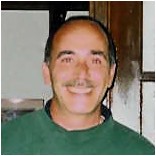
Mike Arato records his life:
“No More Medleys. Indeed, ‘Enough Is Enough.’”
hotdiscomix chats with Mike Arato — remixer, DJ, family man, airline manager, photographer, and one of the creative forces behind the Disconet Top Tune Medleys of the late ‘70s and early ‘80s. Both a witness to and a player in the New York club-music scene in the heyday of disco and funk, Mike Arato recounts his background, the music and venues of the time, his contributions to Disconet and legendary music label T.K., his early mixing techniques, and what he’s up to today.
hotdiscomix: Please tell me about yourself.
Mike Arato: Born in Brooklyn, New York, I completed my education at the City University in 1974 with a B.A. in Fine Arts. My only other interest during my school years was music, and I was a member of a few marching bands during this period. If I wasn’t studying, I was marching and playing a French horn.
hotdiscomix: What inspired you to become a DJ and when did you start DJing?
Arato: The marching band I was performing with was from East New York, and when we weren’t practicing, we were listening to some of the best R&B music available. This is how I came to get the “beat” in my blood, and becoming a DJ seemed a natural next move. I left the band in 1974 and began spinning records that same year.
hotdiscomix: Do you recall the records you were playing at the time?
Arato: Oh yes! I’m still listening to that music, as I believe it was the best of the era. The Trammps, Barry White, Creative Source, First Choice, Al Downing, Shirley and Company, MFSB — just to name a few.
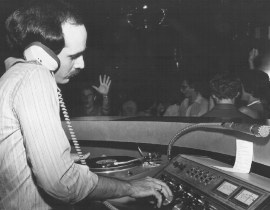
hotdiscomix: Tell me a bit more about your story as a DJ and the clubs at which you performed.
Arato: My very first club was a local hole-in-the-wall called The Rub-A-Dub-Pub in Queens, New York. This establishment had a juke box only and I practically begged the owner to let me set up some equipment and play for his crowd on weekends. He was hesitant but eventually gave me the green light. My first night was difficult, as the locals were accustomed to the juke box and thought my music was too loud and too “black.” I toned it down and threw in a few more “pop” tunes. Slowly the crowd came around and, within three weeks, the owner was pouring more drinks than he ever could have imagined. The volume of the music was back up, my choice of tunes was once again mine, and a bigger and better sound system was installed immediately. Quite honestly, even I was amazed at the transformation. In addition, a doorman had to be hired along with waitresses.
From there I went on to spin at Penrods, Uncle Sam’s, Metro 700, and Malibu — all in Long Island, New York.
hotdiscomix: How would you describe the clientele at the clubs where you played?
Arato: As the clubs were located in Long Island, we had many locals, but due to the close proximity to the NYC area, many residents of Brooklyn, Queens, Manhattan and the Bronx were frequent visitors to these premier Nassau County clubs, too. I and the other DJs I worked with were always playing the most current sounds and did our best to “educate” the crowds regarding new and different music. In general, the age of our clientele ranged from 18- to 35-years. New York being the ethnic melting pot that it is, people representing many different backgrounds made up the visitors’ list.
hotdiscomix: Is there a favorite club at which you worked? A most memorable club experience?
Arato: Uncle Sam’s in Levittown, Long Island, was hands down the best club I ever worked in. My best times were behind the turntables in that place! However, there were just so many good times there that it would be difficult to say what experience was most memorable. I was already dubbing my own remixes on tape and playing them there, and my presentation was so well received that week after week was a thrill.
hotdiscomix: How was playing at Uncle Sam’s?
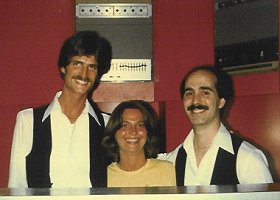
Charles Bailey, Andrea & Mike Arato @ Uncle Sam's
Arato: Uncle Sam’s was indeed the Studio 54 of Long Island, having many similarities in both size and state-of-the-art sound and lighting. To have 5,000+ people a night pass through the doors was not at all unusual. I had the pleasure of working with some very talented DJ’s - Bob Malgioglio, Stuart Best, Charles Bailey & Jimmy Gaffey, just to name a few. I worked mostly weekends and we all alternated on spinning and performing the lighting effects. We always had two DJs on duty on any given night. Live performances were few at first, then increased through the ‘80s. Many big names from both the R&B and New Wave bands have performed on Uncle Sam’s stage.
hotdiscomix: You are one of the beat-mixing pioneers. In the ‘70s, the DJ equipment was poor, turntables had no pitch control and no cueing systems, and the songs had hard-to-control tempos due to live drumming. Please describe your mixing technique as you were faced with these challenges.
Arato: The primitive equipment back then made necessary some creative engineering on the part of any DJ who wanted to present a high quality show. When I think back to some of the techniques we employed to overcome the obstacles you mention, it amazes me that we ever pulled it off. However, we knew what we wanted to achieve and always came up with a method of accomplishing what we envisioned. I don’t think the details are important, it’s just that we did it and it worked. Regarding the “mixing” itself, it was practice, practice, practice. Learning how to overcome blending erratic drum beats from live drums, differences in sound level and EQ from song to song, etc. could only be overcome with rehearsal after rehearsal and then listening to what you did and perfecting it before presenting it to a live audience.
hotdiscomix: Are there any DJs in the industry whom you hold in high esteem? Who and why? What quality or style do they possess that you admire?
Arato: The DJ who I admired most and who was the single most important influence in my style and approach to presenting music was Jimmy Stuard. I spent many a Saturday and Sunday morning, after working all night at clubs, in an after-hours club called 12 West, on the lower west side of Manhattan. Back in the mid ‘70s, Jim was doing very long mixes. It was not unusual to hear two songs playing at the same time, one over the other, for two minutes or more — and flawlessly! Most times the crowd would not know what tune was being brought in as all you could hear was a slight increase in bass. Jim would prolong this mystery for a long time and then slowly make the transformation from the old song to the new one in a way that would make people scream and the whole house explode. I concentrated on this style of presentation and used it throughout my career. It always made for an entertained and happy dance floor.
hotdiscomix: Throughout your time as a DJ, were you ever a Billboard chart reporter, or reporter for other dance music magazines?
Arato: Yes, I was a Billboard Magazine reporter. I also reported to other sources, but their names escape me as it was so long ago.
hotdiscomix: During what period of time were you a Disconet program subscriber? Were you also a subscriber to other remix services?
Arato: I was a Disconet subscriber from 1978 through 1985. Mike Wilkinson’s product was, to me, always a better way of playing material that people already liked. When he asked me to team up with John Matarazzo, I was honored and thrilled. I didn’t really subscribe to other remix services as I was always so busy with Disconet and doing independent remixes for other labels.
hotdiscomix: How important were remix service productions, especially Disconet, in your DJ sets?
Arato: Remix services were always a part of any evening’s repertoire. They would account for about 15 percent of my playlist. If I had not been dubbing my own mixes so much, that percentage probably would have been higher.
hotdiscomix: What role do you think remix services played in the success of dance music?
Arato: Judging from the feedback of visitors to the clubs where I worked, I would say remixes contributed greatly to dance music and its success. It allowed regular visitors to hear the songs they liked, but in many different ways. This kept the music fresh and interesting.
hotdiscomix: You say that you were honored and thrilled to have teamed up with John Matarazzo to produce your first Disconet Top Tune Medley. At the time, John played at Charlie’s West in East Orange, New Jersey, and you at Uncle Sam’s in Levittown, Long Island. What can you tell me about this collaboration, and also about the role of Raul Rodriguez?
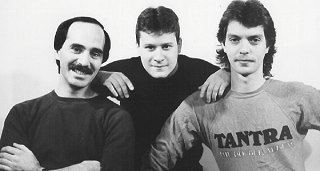
Mike Arato, John Matarazzo & Raul Rodriguez
Arato: The combination of John and myself was Mike Wilkinson’s idea. I really didn’t know John at the time, but when we met at Mike’s office, we immediately got along and I knew we would work well together. Over the years we became friends and our habits took on a very good spirit of teamwork. When we were working at making the medleys, we worked hard and put in some long hours. I can remember starting at about noon at many sessions and not quitting until almost noon the next day. Most of the work was done at Mike Wilkinson’s apartment in uptown Manhattan. John and I would take turns rehearsing the mixes (sometimes 20 or 30 times before we were content with the overlay) and Raul Rodriguez would record the work and do any necessary splicing. We would not let anything be recorded unless we were positive that it could not be done better. We set high standards and stuck to them. Although we would sometimes go out to a club together after a session to unwind, we always kept a professional attitude while creating these mixes. With regard to Raul, his role was to assist in operating the recording equipment as well as to oversee the production. Although John and I worked perfectly together, Raul was there to ensure that production went smoothly and was completed in a timely manner. His creative input was also helpful and he regularly contributed to enhance some of our ideas.
hotdiscomix: How did your medley-production team work? Did one of you choose the track and the other mix it, or did you use a more integrated approach? What tricks did you use for the productions? Were there any differences among each medley production?
Arato: John and I developed the ideas and Raul assisted in the recording phase. We were always given the playlist prior to the session. Mike Wilkinson and Raul would determine which tunes would be used and give the list to us. John and I would take the list and make a preliminary sketch of the “order” in which we would present the material. We would usually place them in order of “beats per minute” with the slower tunes to start and working upward toward the faster ones. This always seemed to work best and it created an increasing excitement for the dance floor. Then we took whatever songs we decided would be the first two and have a discussion on how we wanted to perform the mix — long overlay, fast overlay, quick snap, tape edit mix, etc. Then the rehearsal would begin, which was always long and laborious. When we were happy with the mix, Raul would record it. Upon playback, we would make a decision either to let it be or work on it again. This whole procedure would happen only for two songs! You can imagine how much time went into producing a medley of 20 or 30 tunes.
Despite some occasional fancy editing, most of our work was “live” and true to form. We did not rely on any electronic gadgetry or perform any secret operations to accomplish our sound.
Regarding the “differences” between the various medley productions, there really weren’t any. Each year seemed like the last, as we had a very strong work ethic and used the same procedures for accomplishing the task at hand. It always went smoothly, despite the lengthiness of each session. I think we probably put in about 36 to 48 hours of work for each medley, and that was without wasting time or taking long breaks. We worked equally hard on each one, so no specific medley stands out as taking more time or needing extra work. I would have to say that the first production (1979) probably took the longest, since we all had to get used to working with each other and the new equipment.
hotdiscomix: The Disconet Top Tune Medleys from 1979 to 1985, except for 1982, were a product of your team’s work. Why did Casey Jones mix the 1982 medley?
Arato: I really have no idea why Mike Wilkinson chose not to use John [Matarazzo] and me for the 1982 medley. I don’t think John ever knew, either. When Mike contacted us to do 1983, we just smiled and went back to work.
hotdiscomix: Of all your medley creations, is there one that you prefer or that has special meaning to you?
Arato: They are all special to me. I could not single out any particular work and say it meant more to me than another. There is a part of me in each one of those pieces and, because of that, I love them all.
hotdiscomix: Disconet issued your last medley production — the 1985 Disconet Top Tune Medley — in March 1986. Two months later, Mike Wilkinson passed away. At the time, was he still working for Disconet or had he already left the service?
Arato: During the production of the 1985 medley, Mike was really not around at all. My guess is that he was already very sick. Raul [Rodriguez] did not say much about it at the time, so I wasn’t too certain about the cause of his illness. When I heard that he passed away, I was very sad. I think Raul was trying to keep the label going on his own, but without Mike, it wasn't destined to last. Mike Wilkinson was really the “personality” as well as the “heart and soul” of Disconet records.
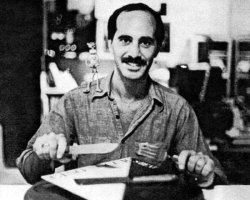
hotdiscomix: Besides your medleys, you produced three remixes for Disconet: “Rhythm Of The World”, “Pretty Woman” and “Fill Me Up”. Are these studio productions or did you use reel-to-reel tapes and razor blades?
Arato: Reel-to-reel and razor blades. I had become quite proficient with the blade, so these songs were a combination of overlay and chopping.
“Rhythm Of The World” Remix: Mike Arato gives Gino Soccio a whole new slant.
The first time Gino Soccio went to a Montreal disco, Gino said “When I saw people going crazy to my music, it literally sent chills through me.” That was “War Dance” by Kebekelektrik, which was Gino on just about all 48 tracks. People still go crazy to “Dancer” from Gino’s first RFC/Warner LP, and are starting to from his second solo LP entitled “S-Beat.” Mike Arato, who co-produced “No More Medlies/1979 Top Tune Medley” with John Matarazzo (Volume 3, Program 6) has remixed one of the cuts on “S-Beat” for you entitled “Rhythm Of The World.” Mike plays at Uncle Sam’s in Levittown, Long Island, and in between trying to straighten out co-DJ Charles Bailey, Mike installs sound systems and sleeps in his spare time.
“Rhythm Of The World” is a shade over 6 minutes on Gino’s LP, with an intentionally light bottom. Mike has given the song a new introduction designed to permit better overlays. The middle part of Mike’s remix is basically the original version. The ending is longer with several spots to get out, including a dead end.
hotdiscomix: In the late ‘70s, you and Steve Thompson produced several 12-inch disco mixes, mostly for T.K. Records. What was your primary role in these productions and how did this collaboration with Steve and T.K. begin?
Arato: Steve worked briefly at Uncle Sam’s and we knew each other previously from the Long Island circuit. One of his former employers was a friend of Henry Stone, and so Steve had an “in” with T.K. Records. I was invited to collaborate because of my skills with remixing and editing. My primary role was to take an existing tune that T.K. was hot on and extend or remix it in an attempt to increase play and exposure in the nightclubs. I worked closely with some very talented engineers in some “top notch” New York studios. It was a very exciting situation.
hotdiscomix: A few years later, in the early ‘80s, you worked on a variety of 12-inch and album productions for a number of record labels, including Matra, Prism and Venture. Among these productions are singles by Tina Fabrik, Pure Energy and Cheri, and albums such as Lime’s very successful “Your Love.” Please tell me something about these recordings.
Arato: I was contracted by these labels due to my success with some of the T.K. remixes. Again, a very exciting (although highly laborious) time. I was spinning at Uncle Sam’s all night, then going straight to whatever studio was leased and working all day. Very little time for sleep. Lime and Tina Fabrik were remixed in Canada. I enjoyed working at the studio there and got to meet Sting who was laying down some tracks in the next room. Cheri was remixed in a studio in New Jersey. Lots of hours and sleepless nights, but a fun project.
hotdiscomix: Some of your remixes are Canadian productions. What are your impressions of the Canadian disco sound? What characteristics of it do you particularly enjoy or dislike?
Arato: Working with Joe LaGreca and Denis LePage was a treat. Although Joe was the “business” guy, Denis was a musical genius and very easy to work with. I quickly came to thoroughly enjoy the Canadian sound and put their music in the right direction without much effort. I think what I liked most about Denis’s sound was the mixing of both American & European feeling in the production. It made for a very different and interesting disco tune.
hotdiscomix: Did you used to test tapes or acetates of your mixes by playing them in front of club crowds before their official release? If so, how did these experiences impact your final mixes?
Arato: Due to some legalities, I was not always allowed to preview new music at my club prior to official release. However, I was always allowed to make some unreleased dubs of my work while in the studio — instrumental, acapella combos — and this I really enjoyed because I knew that no one else would have them. The dancing crowd at Uncle Sam’s would always go crazy for unique mixes of songs they already liked.
hotdiscomix: What was your first remix published on vinyl and what was your most popularly acclaimed remix?
Arato: First remix on vinyl was “Fly Me On The Wings Of Love” [T.K. Disco] by Celi Bee, who, by the way, was a great person and fun to work with. The most popular was probably a tie between “Murphy’s Law” [Venture] by Cheri and “The Break” [T.K. Disco] by Kat Mandu.
hotdiscomix: Have you won any awards for your remixes?
Arato: I never received an award for a remix or an original mix… their money was enough for me.
hotdiscomix: I have read that you also installed sound systems. What can you tell about this work?
Arato: The first system I installed was in the small bar where I got my first gig: a very simple and basic operation with Bose speakers, a Sony mixer and two completely different turntables with NO pitch control — imagine the miracles I had to perform!
Two years later, when Uncle Sam’s hired me, I talked them into an upgrade as I thought their system too primitive for the room’s potential. They had inexpensive woofers and no tweeters at all. I got them to drop $10,000.00 on JBL tweeter clusters and Richard Long woofers, same as the Paradise Garage. Their mixer was a used piece of garbage from a radio station with no cueing. I advised them to buy a new Bozak mixer — they did. Although I was not an active part in the installation, I was credited with the design. Needless to say, this new system blew everybody away, including me!
Later on, I did the same for a great Long Island club where I worked called Malibu.
hotdiscomix: In 1989, you ended your DJ career and left the music business. What was the reason behind your decision?
Arato: I decided to close this chapter of my life in September of 1989. It was a hard choice, but, in my opinion, a necessary one.
I have two children who were, at the time, 11 and 9 years old. Between working all night in clubs, remixing in studios, and doing edits for WBLS, a very popular NYC R&B radio station, I was not spending enough time with my kids. Had I continued with this lifestyle, my children would have grown up not really knowing me or I them. I had to make a change and was not satisfied with the thought of cutting back and being just a part-time DJ. With me it was “all or nothing,” as I truly loved what I did. Ergo, I chose the family over the career. My kids are now 27 and 25 and, although I will always miss the thrill of being a DJ and still think of what “might have been,” I am very glad of the decision I made.
hotdiscomix: Do you still have your complete record collection, or have you scrapped or sold your “junk” records over time?
Arato: I still maintain a collection of approximately 800+ vinyl discs, both LP and 12-inch singles — even some 45rpm imports from Europe and Canada. It is not the amount I once had, but I held on to what I believed to be the “high quality” and valuable pieces, along with the songs that were my favorites.
hotdiscomix: What are your impressions of today’s club-music scene?
Arato: Although not a regular visitor to nightclubs anymore, I still drop in on a club here and there. The music may be different in sound, with an emphasis on the world’s obsession with technology, but the excitement and energy level from quality sound with a driving beat hasn’t changed a bit.
hotdiscomix: What have you been doing after your DJ career?
Arato: Two months after leaving the music business, I secured an entry-level job with AMR Corporation, the parent company of American Airlines. I worked my way up through the ranks to become a general manager within six years. I was stationed in many cities across the country, including West Palm Beach, FL, Providence, RI, San Jose, CA, San Francisco, CA, Denver, CO, and finally, Fort Lauderdale, FL. I took an early retirement in 2001 as the airline industry was becoming very stressful and unstable. Since I was already a Florida resident (retirement capital of the country), I thought it was a good time to make a transition to a final career in a semi-retired capacity.
hotdiscomix: In December 2001, you founded your company, PhotoGraphic ArtWorks, Inc. Please tell me something about your work as a photographer.
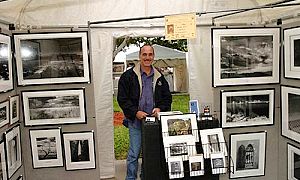
Arato: I started with photography in high school. It has been a passion of mine since 1969. Being a student of art in college, I always leaned toward the “artistic” side of the medium, not having much interest in commercial photos. Since I had good paying jobs through my years as a DJ and my career with the airlines, I was always able to indulge my passion with B&W photography and not have to worry about using it to support my family. When I retired from American Airlines, I thought it would be fun to try and make a decent supplemental income by selling my work. This extra money would enable me to support my artistic habit. So far, it’s working just fine. Most of all, I am once again in a “creative” field with high satisfaction and stress-free work habits. I participate in some twenty to thirty art festivals a year and, when I’m not marketing my work, I’m behind the lens and in the darkroom. It’s heaven to me.
More information is available on my website: www.photographicartworks.com
hotdiscomix: Mike, on behalf of hotdiscomix, I thank you so much for sharing your story and taking us back in time. It definitely sounds as though you had a blast. Your many productions are a testament to your great skill in the studio and the memorable and unparalleled music of that era. I am confident that they will continue to move a great number of listeners and keep disco alive.
Arato: Steffen, I hope this information has been helpful. I am very flattered that you chose to interview me and I think your website is top notch. Please feel free to contact me at any time… and I will be glad to share more of my most cherished memories.